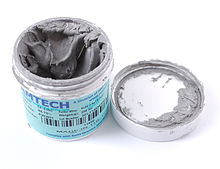Solder paste
Solder paste (also: solder paste) is a pasty mixture of solder metal powder and flux and is mainly used for soldering surface-mountable components ( SMD ) in electronics production using reflow soldering . There are also solder pastes for hard soldering based on copper / zinc and silver and for resistance soldering.
( Soft ) solder paste suitable for SMD soldering in electronics production consists roughly of 90% of spheres of a tin alloy and the rest, i.e. 10 percent, of flux - in each case in percent by mass. Since the density of the solder metal is a multiple of the density of the flux (made of resin , oil, solvent, salt, water), the proportions of these two components are roughly 1: 1 - that is, about 50 percent by volume .
Today, soft solder for electrics and electronics in solder paste is generally lead-free ( RoHS ) and typically consists of 96.5% Sn , 3.0% Ag and 0.5% Cu .
Classification
Solder pastes are classified according to J-STD-005 by the ball size:
| class | not greater than |
Max. 1% greater than |
min. 80% between |
Max. 10% smaller than |
|---|---|---|---|---|
| Type 1 | 160 µm | 150 µm | 150-75 µm | 20 µm |
| Type 2 | 80 µm | 75 µm | 75-45 µm | 20 µm |
| Type 3 | 50 µm | 45 µm | 45-25 µm | 20 µm |
| Type 4 | 40 µm | 38 µm | 38-20 µm | 20 µm |
| Type 5 | 30 µm (28 µm) | 25 µm | 25–10 µm (min. 90%) | 10 µm |
| Type 6 | 20 µm (18 µm) | 15 µm | 15–5 µm (min. 90%) | 5 µm |
| Type 7 | 15 µm | 11 µm | 11–2 µm (min. 90%) | 2 µm (max. 1%) |
| Type 8 | 11 µm | 10 µm | 8-2 µm |
The solder paste is applied about 150 µm thick (depending on the type of paste, the finer the thinner) in the screen or stencil printing process on the soldering pads (soldering surfaces) of the circuit board and then the electronic components are fitted onto the circuit board (glued or just pressed into the solder paste) . In addition to the typical stencil thickness of 150 µm, thinner stencils of 120 µm, 100 µm and 80 µm are sometimes used, depending on the requirements. In this case, less solder paste is applied during paste printing. If, on the other hand, more solder paste is required, stencils with a thickness of 180 µm or 200 µm can be used.
soldering
The assembled circuit board is then soldered using the reflow soldering process , whereby the particles of the solder paste fuse with one another and with the pads and component contacts. The flux facilitates the melting process by lowering the surface tension, preventing oxidation and reducing any oxide residues that may be present . The volatile part of the flux evaporates during the soldering process. The non-volatile content is displaced by the liquid solder and collects around the solder joint. A soldered connection with good electrical conductivity is formed between the components and the soldering pads. The volume of the melted solder is around 50 percent compared to the unmelted solder paste.
Storage temperature
For (soft) solder paste, refrigerated storage at 1… 10 ° C is recommended. It should be tempered to 25 ° C for processing. Avoid heating to a higher temperature. When soldering, heating typically takes place above 200 ° C.
See also
- Solder (metal) , with an overview of the solder alloys
literature
- Reinard J. Klein Wassink: Soft soldering in electronics . 2nd Edition. Eugen G. Leuze, Saulgau 1991, ISBN 3-87480-066-0 .
- Wolfgang Scheel (Hrsg.): Assembly technology of electronics . Verlag Technik u. a., Berlin a. a. 1997, ISBN 3-341-01100-5 .
Web links
- Soldering terminology (explanation of technical terms)
Individual evidence
- ↑ Stannol - soldering tin - Sn60Pb40 and Sn63Pb37 technical data sheet, farnell.com, accessed March 31, 2020. - Density: 8.5 or 8.4 g / cm 3 .
- ↑ a b According to DIN 32513
- ↑ Procedures for Handling AMTECH Solder Paste inventecusa.com, Rev. 12/05, probably May 2012, accessed March 31, 2020.


